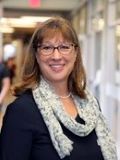|

Jason Andrews
|
|

Karen Densky
|
“Karen, I need to appoint you as department chair,” said the Dean to the 30-year veteran teacher of the English language classroom. This “promotion” was not met with excitement but with trepidation. Moving from a teaching role to a leadership role is often an intimidating experience for many in the TESOL field. The question remains – why? Why is leading one’s peers so much more challenging than leading a class of language learners? Why did this reluctant leader feel lacking in resources and experience despite 30 years in the profession when appointed department chair?
British Columbia Teachers of English as an Additional Language (BC TEAL) attempted to provide support and resources for TESOL professionals in leadership roles by offering a six-week online Leadership Series this year. The cohort of 12 leaders from all sectors of the profession including universities, private language schools, and settlement language programs, came together to learn together and support each other. After the series, the group decided to continue to meet monthly in a community of practice.
The second session of the series was delivered by Jason Andrews, an EAL teacher and graduate student in Educational Leadership. Jason provided a roadmap for exploring what leadership for those in our profession might look like. This approach gave the leaders in our group confidence that we could draw from within as we defined and explored our values and how our positionality can be applied to our leadership roles. We realized that as TESOL professionals we are unique, and our uniqueness can fuel a particularly powerful approach to leadership.
-Dr. Karen Densky
Within the TESOL profession, the experience of moving into a leadership role following years of professional teaching knowledge yet not feeling ready for the new responsibilities of a leadership position, as described by Dr. Densky, is not an uncommon one. McGee, Haworth, and MacIntyre (2015) describe this pattern wherein teachers are “thrust into leadership positions before they feel ready to cope with these new expanded roles” (p. 98). This leads to the question of how we could address this concern in such a way that TESOL teachers moving into leadership positions might feel more confident in assuming these new roles. This is precisely what I attempted to address in my session regarding the development of an authentic TESOL leadership approach.
I realized in examining the suitability of various established leadership models that, as Dr. Densky mentioned, the TESOL profession has a uniqueness to it; it is this uniqueness which supports particular leadership approaches. Additionally, I was curious about this common experience described by Dr. Densky of having years of professional knowledge in the EAL field and yet suddenly feeling that one was ‘starting fresh’. Why couldn’t the years of professional knowledge in EAL education be the basis for a unique approach to leadership informed and framed by these years of experience shared by so many TESOL educators?
As a means of addressing this question, I was drawn to the analogy of race cars and a racetrack. The field of TESOL education could be seen as a distinctive racetrack in which one drives the car of leadership. This track has its own twists, turns, and conditions which require specific tuning, engineering, and modifications of our ‘leadership race car’. For example, one obviously wouldn’t choose to race an SUV in a Formula 1 race on a track designed for this special kind of racing. Similarly, it may not be best practice to employ an approach to leadership that is not well suited to the conditions of TESOL educational communities of teachers and students.
This brings me to the questions of which leadership models are suitable to the uniqueness of TESOL and what kind of professional development might help us begin to construct our specialized leadership race car. If we are designing our own car, why not start with a pre-built race car (leadership model) as a starting point to borrow pieces from. I would call this ‘scouting for race cars’ that might fit the particularity of the EAL track. The model I came across that seemed well suited for the TESOL track is Authentic Leadership (AL). This is a model which Greenier & Whitehead (2016) note has aspects that apply well to conditions of the EAL field. The authors write, “A model for teacher leadership built upon the principles of AL will provide teachers with a frame to better understand and apply their knowledge, experiences, and passion for teaching” (p. 89-90). As a race car, the design of AL seems to run well on the EAL track.
In turn, what are the parts of the AL leadership race car which we can use to begin construction on the EAL leadership frame? Looking to Greenier and Whitehead (2016), there are several components of AL we could pull out:
- self-awareness (a strong understanding of one’s self), relational transparency (being open with others);
- balanced processing (equally considering others’ views when making decisions);
- an internalized moral component (letting one’s moral compass guide decisions).
In trying to develop an approach to leadership authenticated by core TESOL values, the first step is turning inward, bringing out our own authenticity based on prior years of language education practice, sharing and exploring our authentic experiences collaboratively, and then reflecting on what authentically manifests from both self-reflection on our own years of TESOL experiences as well as the shared experiences unique to being a TESOL educator.
In designing my workshop to explore personal and collective authenticity in TESOL education, I found that literature on AL brought up two key means of discovering one’s authenticity: deep self-reflection (Covelli, 2018) and collaborative group work, followed by feedback and reflection (Fusco, O’Riordan, & Palmer, 2015). The BCTEAL Leadership Series was the start of a community of practice (Wenger, McDermott, & Snyder, 2002) to begin, through a series of tasks, of discovering our own individual authenticity and then our shared authentic values and experiences. Through such collaborative exploration the group of TESOL educators-turned-leaders began piecing together an approach to leadership informed by the unique elements that emerged from their individual and shared authentic experiences.
Considering the idea of characteristics unique to TESOL education shared among the larger community, which might provide the basis for an authentic TESOL leadership framework,
I noticed some common and unique characteristics emerged in two insightful instances. First, my department was asked at one point during the last year about our values as TESOL educators, and in a survey, several shared and agreed upon traits came up. Interestingly, when I asked leaders in the BCTEAL Leadership Series to identify traits unique to TESOL education, the same traits came up. These included characteristics such as collaboration, encouragement, relationship-centeredness, community, empathy, diversity, and inclusion. Similarly, some of these traits are brought up in Greenier and Whitehead’s (2016) examination of AL and language education, suggesting that these characteristics align well with AL values and approaches. Additionally, the identification of these traits in two different contexts led me to consider that they might make up some of the authentic core of TESOL education, and in turn, could provide a basis for the establishment of a unique TESOL leadership approach.
We could use these values and the discovery of our own individual and shared authentic approaches to TESOL education to begin creating the leadership race car specialized to the language education track. Through ongoing sessions in a community of practice, this model could develop from the years of shared teaching experience of the group and presented to new emerging TESOL leaders to give them a leadership starting point designed from a collective community of professional knowledge.
In short, as Dr. Densky shared with me in conversation, leadership can be like driving a race car; we might feel alone as TESOL leaders, especially when assuming a new position, but in every race, it’s vital for drivers to come off the track and get the help of one’s pit crew (fellow leaders) to make repairs, adjustments, and fine tune our leadership car, constructing and reconstructing how we navigate the TESOL educational track.
Jason Andrews, MEd, is an EAL instructor at Bow Valley College in Alberta, Canada. He recently completed his Master of Education through Thompson Rivers University where he completed a project examining the construction of an authentic EAL leadership model.
Karen Densky, PhD, teaches at Thompson Rivers University in British Columbia, Canada where she is currently Acting Department Chair and former TESOL Coordinator. She teaches in the TESOL certificate program and the MEd. |

